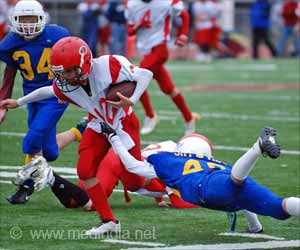Wearing padded helmets and using safe tackling techniques can reduce the risk of having head injuries among young football players, suggests a new study.
- Head injuries are more common among football players
- Using safe tackling techniques and wearing padded helmets can reduce the risk of concussions among young football players
Read More..
“Parents are understandably concerned that their young football players are putting themselves at risk for the same long-term brain or nervous system injuries that are reported in older players,” said Robert Heary, director of the Center for Spine Surgery and Mobility at Rutgers New Jersey Medical School.
“Although concussions causing readily observable signs and symptoms are of great concern to physicians examining football players during and after games, the effects of other head trauma with fewer symptoms also can result in long-term damage.”
The research team monitored 20 members of a youth football team in New Jersey who wore helmets equipped with a system that tracked the number and severity of impacts that each player sustained during their 20-practice, seven-game season.
A tackling coach taught players and coaches safe methods for blocking, defeating blocks and tackling that reduced head contact for both offensive and defensive players. During practices, the players wore Guardian Caps, which are helmets fitted with a padded cover that lessen the number of high-energy head impacts.
“The use of Guardian Caps, safe tackling techniques and the age of participants may have contributed to the very low number of impacts recorded and the complete lack of injuries,” said Heary.
Reference:
- Is Youth Football Safe? An Analysis of Youth Football Head Impact Data - (https://doi.org/10.1093/neuros/nyz563)
Source-Newswise













